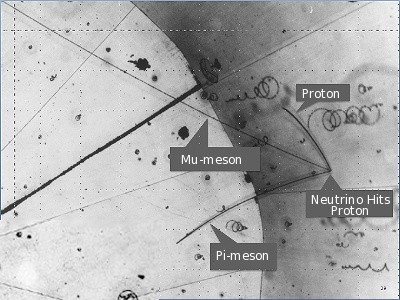
Tachyons
September 26, 2011 When I was in graduate school, I would often see papers about tachyons during my frequent literature searches in the library. A tachyon, named from the Greek word, ταχυς (swift), is a superluminal particle; that is, a particle that travels faster than light. None of those papers were about the discovery of tachyons. They were descriptions of experiments that set limits on how impossible they might be (See, for example, refs. 1-2). Since the speed of light has always been considered to be the speed limit for our universe of normal, slowpoke matter, tachyons would need to have some unusual properties. Tachyons must always move at the speed of light, or higher. Motion at the speed of light would be nearly impossible since tachyons need to gain energy to slow down. A tachyon would need to attain infinite energy to slow to the speed of light, just as ordinary matter would need infinite energy to travel as fast as the speed of light. Tachyons create a fundamental problem in causality if they might be used to transmit information faster than light. Reception of charged tachyons is possible, since they will lose energy via Cherenkov radiation. Cherenkov radiation is the blue glow observed in the cooling water of nuclear reactors. It's caused by charged particles exceeding the phase velocity of light in a medium. There is no known method for generation of tachyons, so a companion transmitter is not yet possible, and causality is saved. There is, however, a patent on another method of faster-than-light communication.[3] One interesting idea about tachyons, proposed by Alan Chodosa, Avi I. Hausera and V. Alan Kostelecký in 1985, is that neutrinos could have a tachyonic component.[4] Through many observations, it's fairly well established that neutrinos oscillate between flavors; that is, a muon neutrinos emitted in a reaction may be detected at a later time as a tau neutrino. Somewhere in this oscillation there might be some hidden tachyons. Naturally, there were naysayers to this proposal.[5] | The first Argonne National Laboratory hydrogen bubble chamber image of the neutrino, taken on November 13, 1970. In this image, a neutrino hits the proton nucleus of hydrogen. |
"This result comes as a complete surprise... After many months of studies and cross checks we have not found any instrumental effect that could explain the result of the measurement. While OPERA researchers will continue their studies, we are also looking forward to independent measurements to fully assess the nature of this observation."[6]Of course, such a discovery requires independent confirmation, but in the field of neutrino physics, there are few laboratories situated to make such a test. These are Fermilab, still reeling from its loss of pivotal position to CERN's Large Hadron Collider, and the Japanese Super-Kamiokande. The measurement capability of these facilities would need to be upgraded in order to see CERN's result. CERN Research Director, Sergio Bertolucci, announced in a press release that CERN welcomes such scrutiny.
"When an experiment finds an apparently unbelievable result and can find no artefact of the measurement to account for it, it's normal procedure to invite broader scrutiny, and this is exactly what the OPERA collaboration is doing, it's good scientific practice... If this measurement is confirmed, it might change our view of physics, but we need to be sure that there are no other, more mundane, explanations. That will require independent measurements."[6]As Yogi Berra said, "It's déjà vu all over again." Another experiment, MINOS at Fermilab, saw the same thing in 2007. The MINOS data, however, were not accurate enough to make any claims.[8] MINOS may be up and running again in just six months.[8] It took OPERA three years of data collection to come to its conclusion, so don't throw out (or delete) your relativity books just yet. It's appropriate to repeat the exclamation of I.I. Rabi at the discovery of the muon, "Who ordered that?"
References:
- C. Baltay, G. Feinberg, N. Yeh and R. Linsker, "Search for Uncharged Faster-than-Light Particles," Phys. Rev. D, vol. 1, no. 3 (February 1, 1970), pp. 759-770.
- D. F. Bartlett, D. Soo and M. G. White, "Search for tachyon monopoles in cosmic rays," Phys. Rev. D, vol. 18, no. 7 (October 1, 1978), pp. 2253-2261.
- David L. Strom, "Hyper-light-speed antenna," US Patent No. 6,025,810, February 15, 2000.
- Alan Chodosa, Avi I. Hausera and V. Alan Kostelecký, "The neutrino as a tachyon," Physics Letters vol. B150, no. 6 (January 24, 1985), pp. 431-435.
- Richard J. Hughes and G.J. Stephenson Jr., "Against tachyonic neutrinos," Physics Letters vol. B244, no. 1 (July 12, 1990), pp. 95-100.
- OPERA experiment reports anomaly in flight time of neutrinos from CERN to Gran Sasso, CERN Press Release No. PR19.11, September 23, 2011.
- Jason Palmer, "Speed-of-light experiments give baffling result at Cern," BBC News, September 22, 2011.
- Eryn Brown and Amina Khan, "Faster than light? CERN findings bewilder scientists," Los Angeles Times, September 23, 2011.
- Particles found to break speed of light, Reuters, September 22, 2011.
- Opera Experiment Web Site.
- D. F. Bartlett, D. Soo and M. G. White, "Search for tachyon monopoles in cosmic rays," Phys. Rev. D, vol. 18, no. 7 (October 1, 1978), pp. 2253-2261.